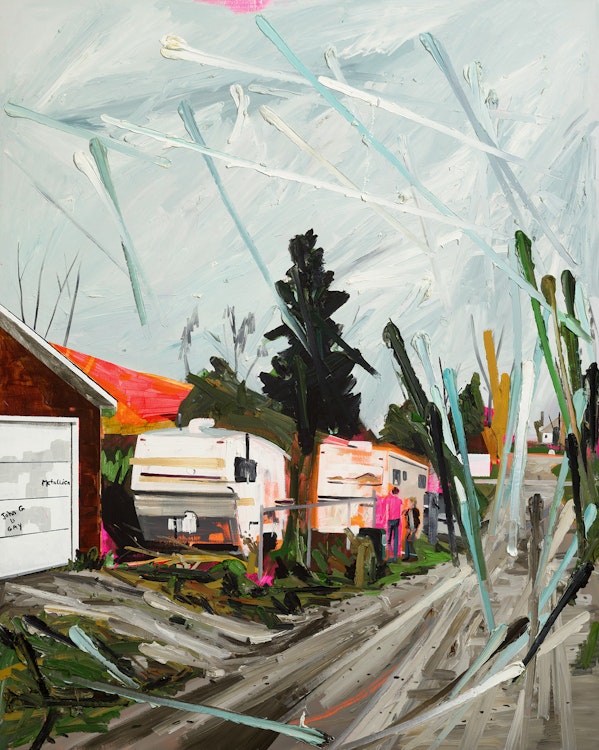Alley by Kim Dorland

Kim Dorland
Alley
oil and acrylic on canvas mounted to board
signed, titled and dated 2006 on the reverse; signed, titled and dated 2006 along the upper edge; unframed
60 x 48 ins ( 152.4 x 121.9 cms )
Auction Estimate: $25,000.00 - $30,000.00
Price Realized $31,200.00
Sale date: November 22nd 2021
Private Collection, New York
“Homecoming”, Contemporary Calgary, Calgary, October 16, 2014 - January 18, 2015
Katerina Atanassova, “You are Here: Kim Dorland and the Return to Painting” in Katerina Atanassova, Robert Enright and Jeffrey Spalding, “Kim Dorland”, Vancouver/Berkeley and Kleinburg, Ontario, 2014, pages 6, 44, 52, 108, reproduced page 102
Jeff Hamada, “Kim Dorland” [online article], Booooooom.com, Vancouver, June 16, 2014, reproduced
Katy Cowan, “Canadian suburban life by Kim Dorland” [online article], CreativeBoom.com, UK, June 19, 2014, reproduced
Murray Whyte, “Angst and Exuberance”, Galleries West Fall/Winter 2014, September 1, 2014, page 42 reproduced
Kim Dorland was inspired by artists such as Tom Thomson, Emily Carr, David Milne, and members of the Group of Seven - and their quest for bold, authentic, and expressive visual language. The artist goes so far as to credit the art of these painters with saving him, proclaiming: “Before I found art, I had no sense of the future. I could have ended up in a dead-end job or even jail, not because I was violent but because I was thoughtless. Then I found this. It was all I wanted.”
“Alley” was painted in 2006, when Dorland had solidified his personal artistic style and was beginning to see significant success in the gallery world. The oil painting depicts activity in an alley, likely in winter or early spring, with two trailers parked on a lawn alongside a garage. The ground and sky are painted in heavily textured shades of grey; the trailers, though predominantly white, appear to have a neon pink and orange glow surrounding them and three standing figures. The scene, with graffiti on the garage door, recalls the gritty, working-class environment Dorland grew up in and often references. Curator Katerina Atanassova observes that “Dorland’s world - although referencing locales in his native Wainwright, Alberta - is no longer focused on a specific place but rather represents a kind of ‘anywhere’.” In many of Dorland’s works, including “Alley”, the artist has challenged the conventional notion of the romantic Canadian landscape. Jeffrey Spalding remarks on how Dorland’s scenes of Canadian life and terrain are important because they are truthful. He writes “It may still be plausible to manufacture an encounter with pristine wilderness, but it is not our predominant, day-to-day lived reality. [...] Kim Dorland’s figuration and landscapes sit as a continuity of Canadian art history, not as an anomaly.”
“Alley” is a particularly gestural work, with thickly-applied paint in the sky and long slashes of paint moving upward and into the sky. In an interview with Kim Dorland, Robert Enright inquires about specifically this oil painting, asking: “Alley, an early work, is like a scatter of pick-up sticks that reads less as landscape depiction than as a kind of abstraction. ... Were you aware at the time that you were mixing abstraction with a version of realism?” The artist responded with: “That was exactly what I was trying to do. My master’s thesis was about combining representation and abstraction at the same time. I was trying to crumple up a piece of representation and pull it apart. I was also thinking a lot about cubism. The two things I was dealing with were abstraction and overt play.”
Share this item with your friends
Kim Dorland
(1974)
A native of Wainwright, Alberta, Dorland relies heavily on his tumultuous experiences growing up, translating into works that challenge preconceived notions of the Canadian wilderness. He studied at the Emily Carr Institute of Art and Design in Vancouver before earning his MFA at York University in Toronto in 2003. Dorland was also an artist-in-residence at the McMichael Canadian Art Collection in 2014.
With an emphasis on demystifying the idea of terra nullius—the void, pristine, virgin land often idealized by historical Canadian painting and art history—the artist often incorporates contemporary figures and objects in a rugged environment emphasizing one's place in the landscape. Dorland works in a variety of media, including neon pigments, spray paint and even inkjet technologies. Works often include hidden symbols and references to the relationship humans have on the landscape they inhabit. Graffiti, cars, toys and modern infrastructure populate Dorland’s landscapes, making a contemporary comment on the traditionally barren Canadian landscape throughout art history. In each work, strong formal elements of line, contrast, and colour figure prominently to create visually complex imagery. In doing this, the artist forms a dialogue with celebrated twentieth century Canadian painting technique rather than a rejection of tradition.
As one of Canada's leading contemporary painters, Dorland exhibits frequently in Canada from coast to coast at the institution and gallery level with regular art fair participation in Toronto and New York. His works are part of the collections of The Art Gallery of Alberta, Musée d’art contemporain de Montréal, Bank of Montréal, Royal Bank of Canada, and The Glenbow Museum among many other private and international collections.

